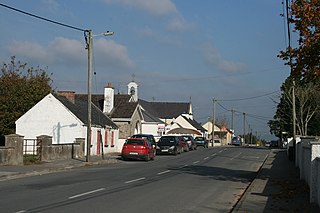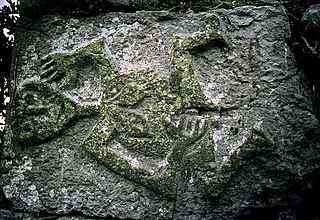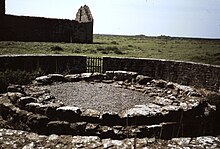
Irish round towers are early medieval stone towers of a type found mainly in Ireland, with two in Scotland and one on the Isle of Man. As their name Cloigtheach indicates, they were originally bell towers, though they may have been later used for additional purposes.

Dromineer is a small village and townland in County Tipperary, Ireland. It is on the shores of Lough Derg, 8 km north-west of Nenagh on the R495 road. It is also a civil parish in the historical barony of Ormond Lower. Historic documents describe the places as "Dromynnyre"; the earliest form of the name dating from 1302 was Dromynwyr.

A sheela na gig is a figurative carving of a naked woman displaying an exaggerated vulva. These carvings, from the Middle Ages, are architectural grotesques found throughout most of Europe on cathedrals, castles, and other buildings.

Roscrea is a market town in County Tipperary, Ireland. In 2022 it had a population of 5,542. Roscrea is one of the oldest towns in Ireland, having developed around the 7th century monastery of Saint Crónán of Roscrea, parts of which remain preserved today. The town is in a civil parish of the same name.

Aughagower or Aghagower is a small village in rural County Mayo in western Ireland. It is 6 km south-east of Westport. Aughagower has around forty houses, a pub and a shop, with a clear view of Croagh Patrick from Reek View. It is also at the centre of Aghagower civil parish which covers an area of 86.1 square miles. The village is known for its links to Saint Patrick and Tóchar Phádraig, the pilgrimage route from Ballintubber Abbey to Croagh Patrick.

Two-Mile Borris is a village in County Tipperary, Ireland. The village is located on the L4202 road at the junction with the Ballyduff Road, close to the N75 and 4.7 mi (7.6 km) from Thurles town centre. It is also situated 1 mile from junction 5 of the M8 motorway. Its population was 572 as of the 2016 census, up from 502 in 2006. It is situated in the townland of Borris which is part of the civil parish of Twomileborris in the ancient barony of Eliogarty.
Clonoulty is a small village and a civil parish in County Tipperary, Ireland. It is one of nine civil parishes in the barony of Kilnamanagh Lower. It is also one half of the ecclesiastical parish of Clonoulty-Rossmore in the Roman Catholic Archdiocese of Cashel and Emly. Clonoulty may also refer to a slightly larger area which forms one half of the catchment area for Clonoulty-Rossmore GAA club.

The Church of St Mary and St David is a Church of England parish church at Kilpeck in the English county of Herefordshire, about 5 miles from the border with Monmouthshire, Wales. Pevsner describes Kilpeck as "one of the most perfect Norman churches in England". Famous for its stone carvings, the church is a Grade I listed building.

Gortnahoe, also known as Gortnahoo, is a village in County Tipperary, Ireland. It is on the R689 road5 km (3.1 mi) south of Urlingford, County Kilkenny, where the N8 Dublin–Cork road can be accessed. Gortnahoe, pronounced "Gurt/na/hoo" by the locals, is part of the parish of Gortnahoe–Glengoole.

Kilnaboy or Killinaboy is a village, townland and civil parish in County Clare, Ireland. It is located in the Burren, and as of the 2011 census the area had 347 inhabitants.

Old Sakshaug Church is a preserved, former parish church of the Church of Norway in Inderøy Municipality in Trøndelag county, Norway. It is located in the village of Sakshaug, just west of the municipal centre of Straumen. It is the former main church for the Inderøy parish which is part of the Stiklestad prosti (deanery) in the Diocese of Nidaros. The stone church was built in a long church style around the year 1184 using plans drawn up by an unknown architect. The church seats about 200 people.

Leigh is a townland in the civil parish of Twomileborris, County Tipperary, Ireland. It is 8.68 square kilometres (3.35 sq mi) in area. At the time of the 1911 census, there were 17 households in the townland. As of the 2011 census, Leigh townland had a population of 64 people in 18 occupied houses.
Redwood is a townland in the historical Barony of Ormond Lower, County Tipperary, Ireland. It is also an electoral district in the Dáil constituency of Offaly having previously been part of the Tipperary North Dáil constituency.

Roscommon County Museum is a museum dedicated to the history of County Roscommon, and is run by the County Roscommon Historical and Archaeological Society. The museum is housed in a former Presbyterian church in Roscommon town.

The Anglican Church of St Martin in Fiddington within the English county of Somerset dates from the 11th century and has been designated by English Heritage as a Grade II* listed building.

Castlemagner is a village, townland and civil parish in the Duhallow area of north-west County Cork, Ireland. Castlemagner is within the Cork North-West.

Dísert Óengusa is a medieval hermitage and National Monument located in County Limerick, Ireland.

The Liathmore Sheela-na-gig is a carving on the northern doorway at the larger church ruin at Liathmore monastic site in the townland of Leigh, County Tipperary in Ireland. The Sites and Monuments Record number for the sheela na gig carving is TN042-055004.

The Kiltinan Church sheela-na-gig is a carved depiction of a nude woman exposing her vulva which used to be part of Kiltinan Church ruin near Fethard, County Tipperary as a quoin stone in the Southwestern corner of the church. However, it was stolen in 1990 and has not been located since. Fethard Historical Society issued a Wanted poster to help with the retrieval. The National Sites and Monuments no. is TS070-101003.

The Fethard Abbey Sheela-na-gig is located in a wall on the grounds of the former Augustinian Abbey in Fethard. Its National Sites and Monuments number is TS070-040030. One of its earliest mentions is in the School Collection which also includes a black and white photograph.





















